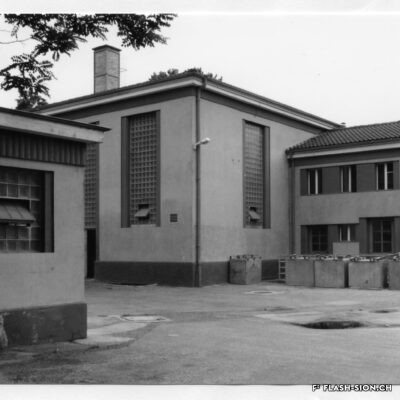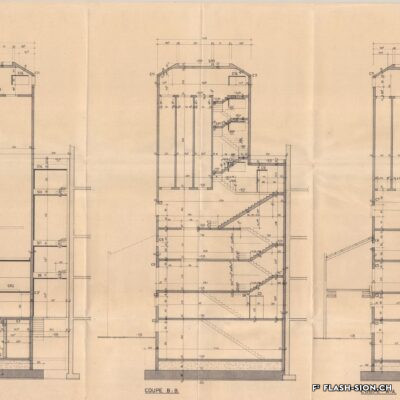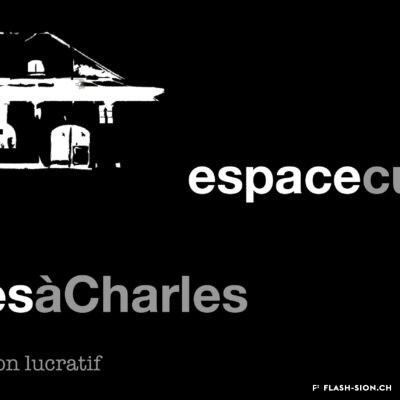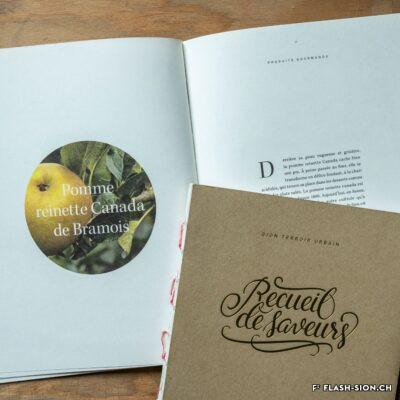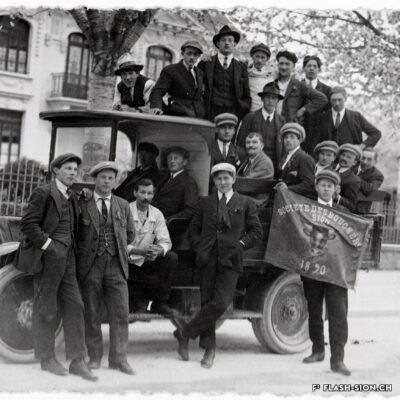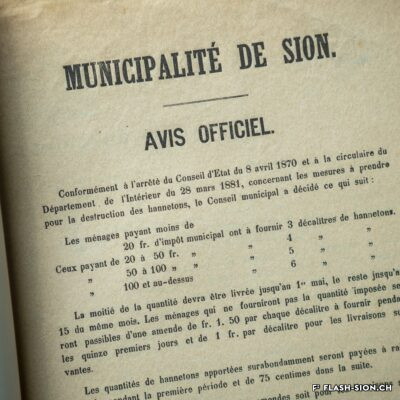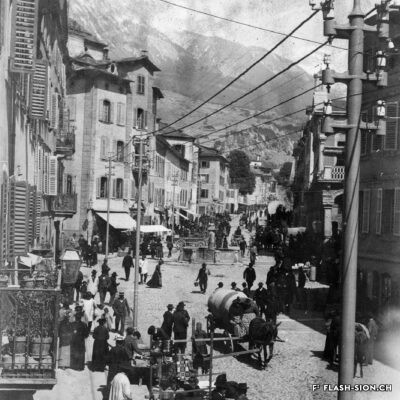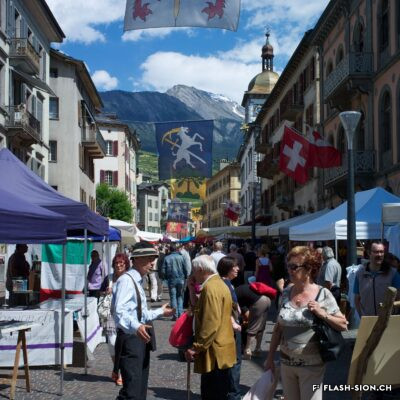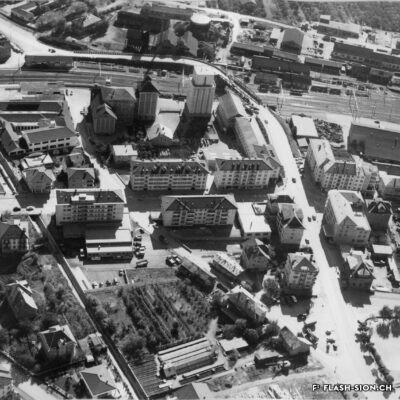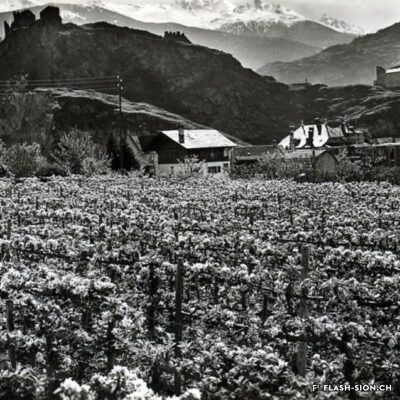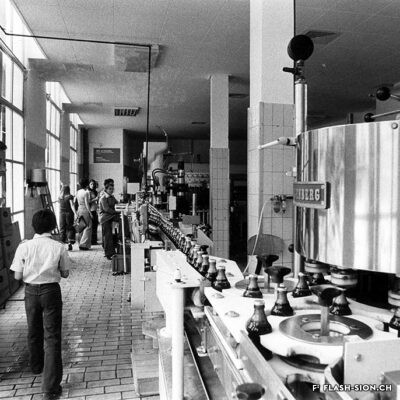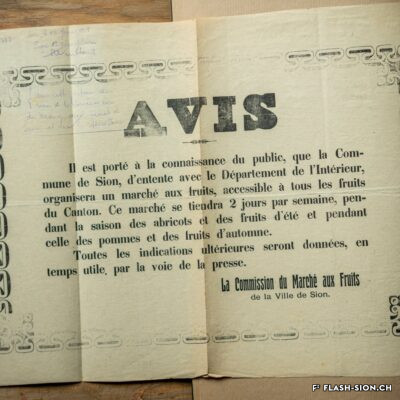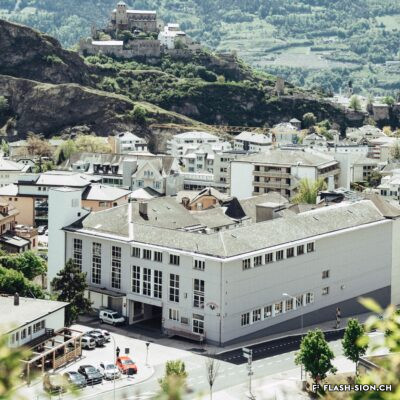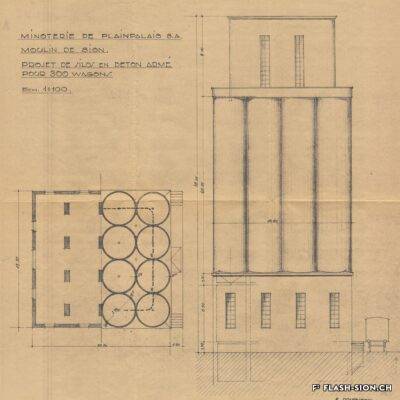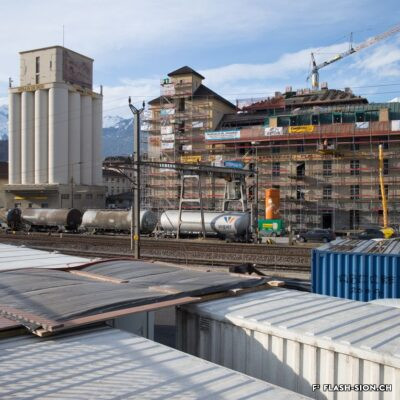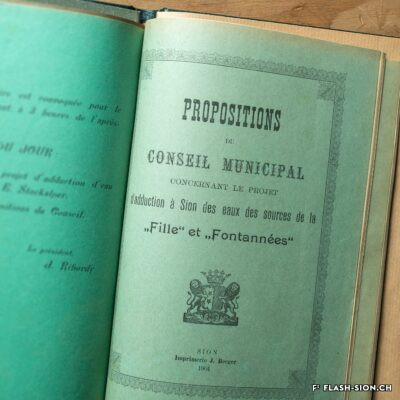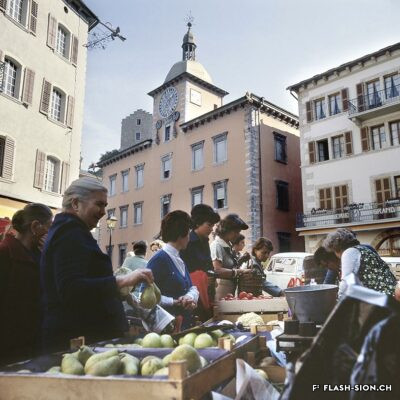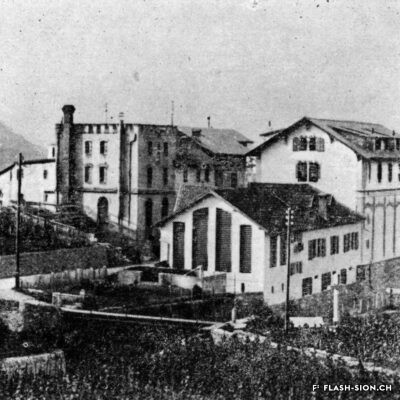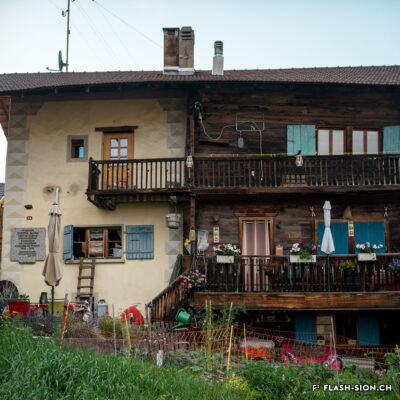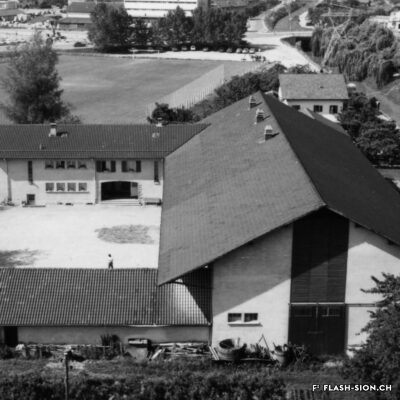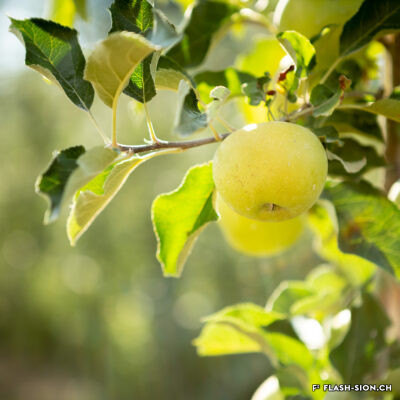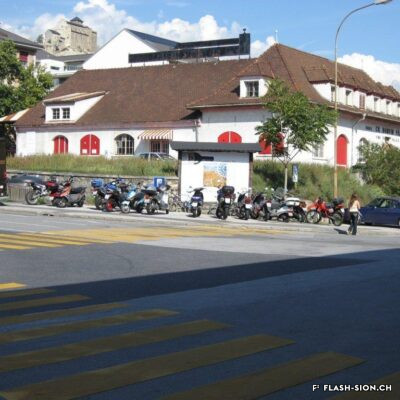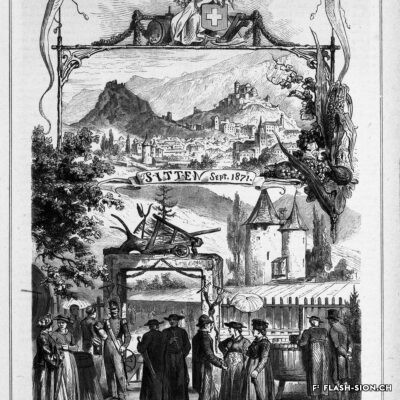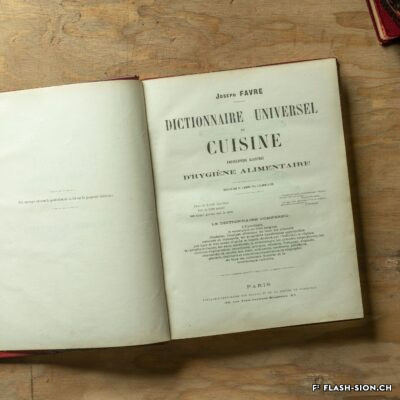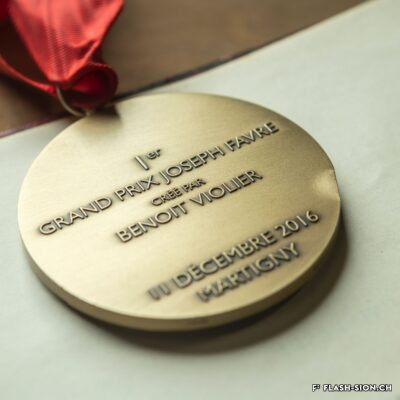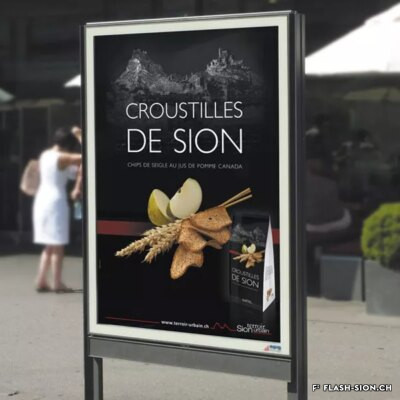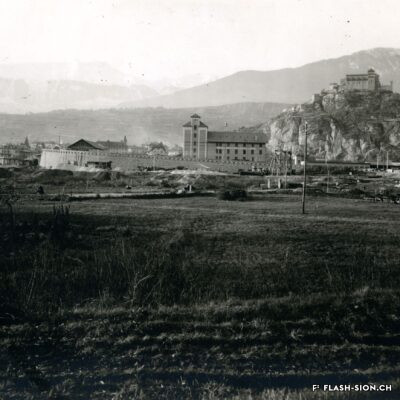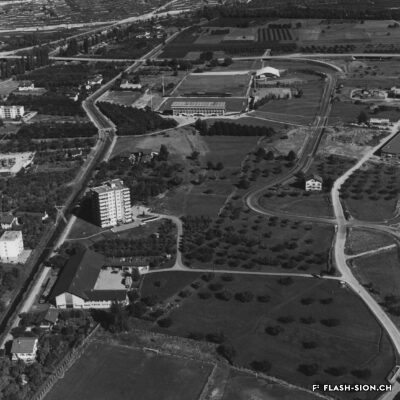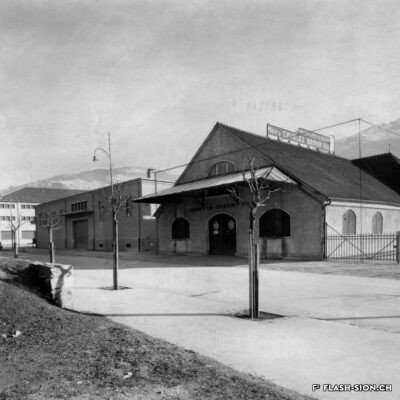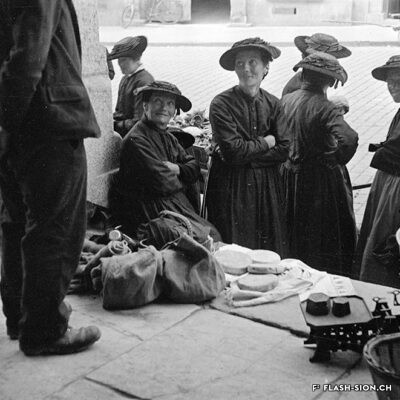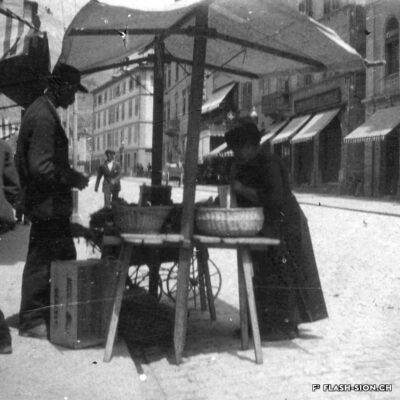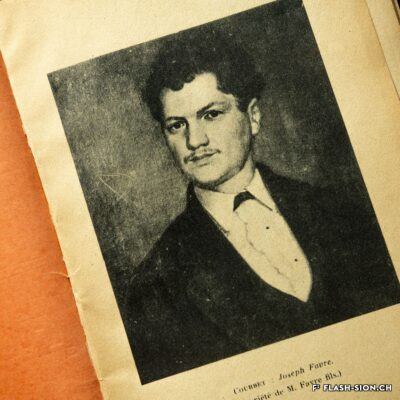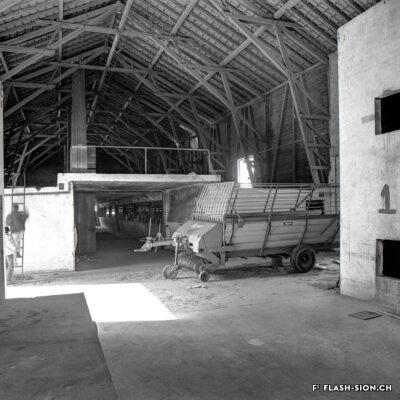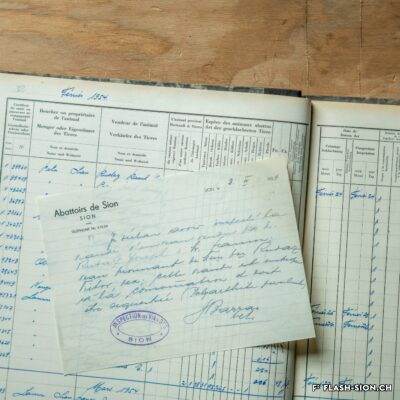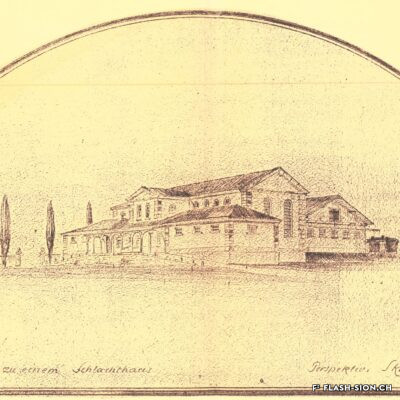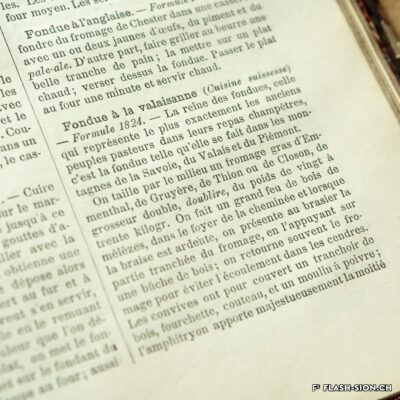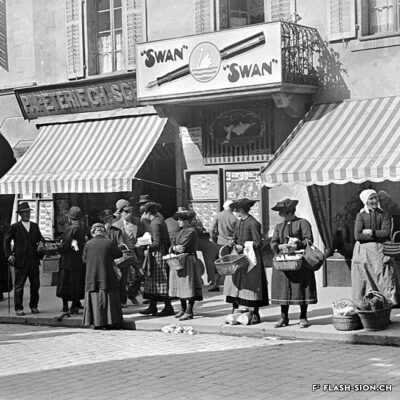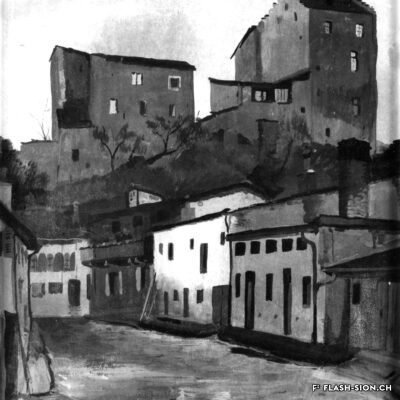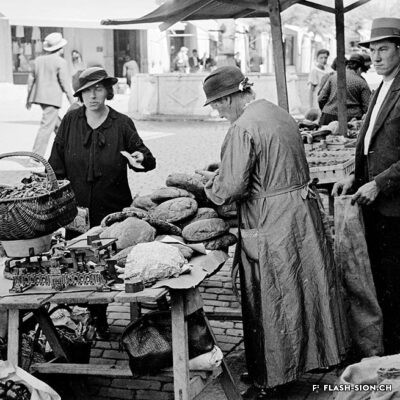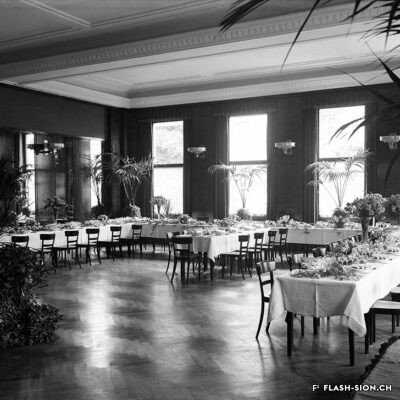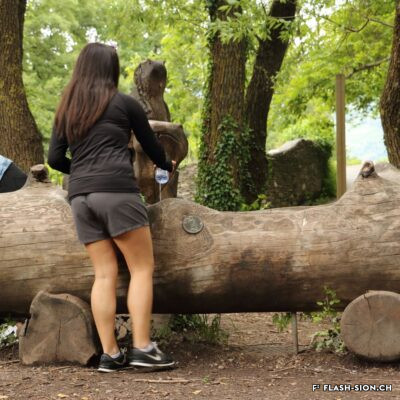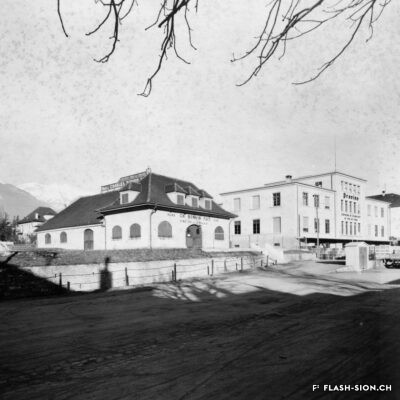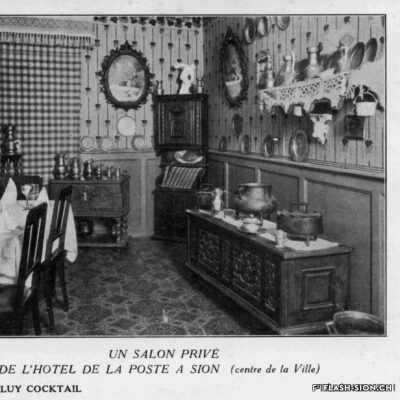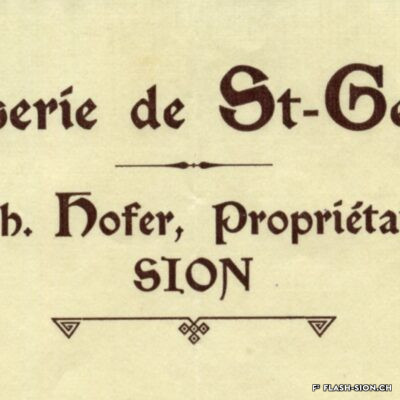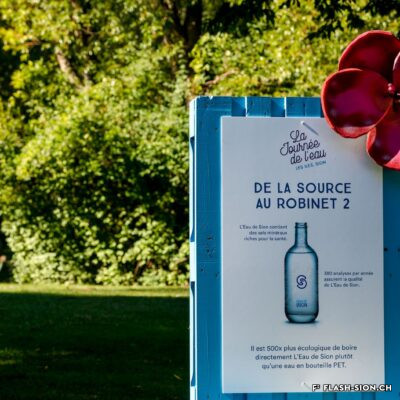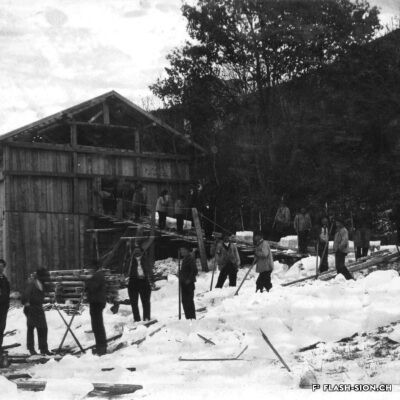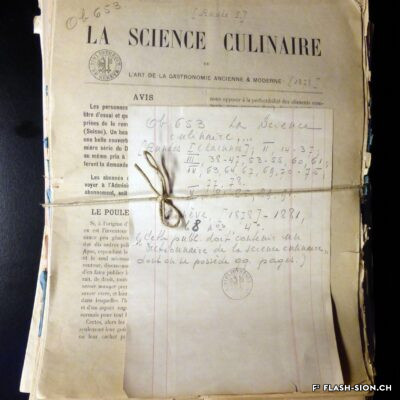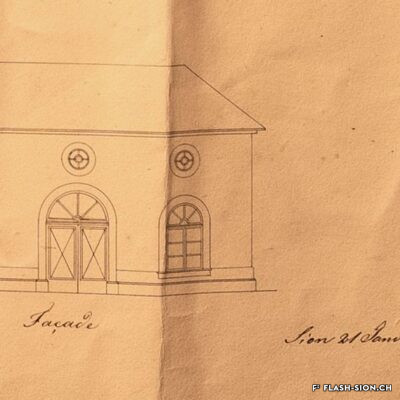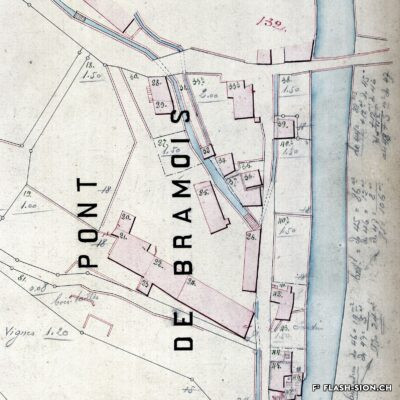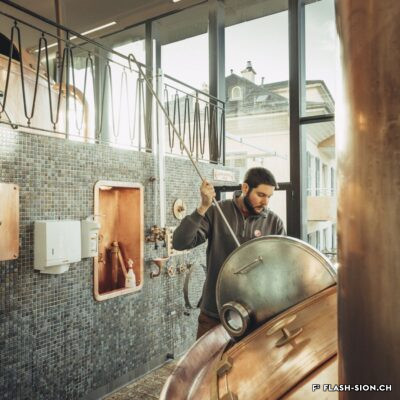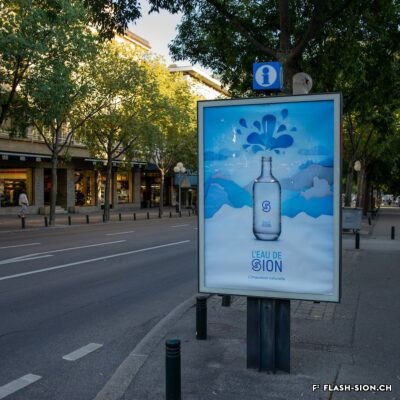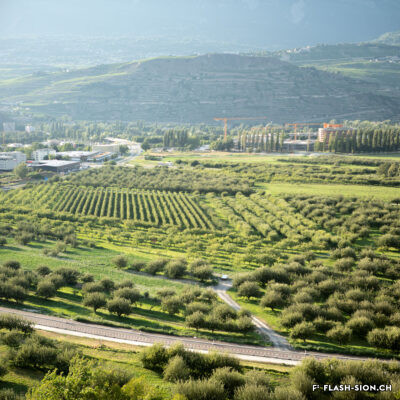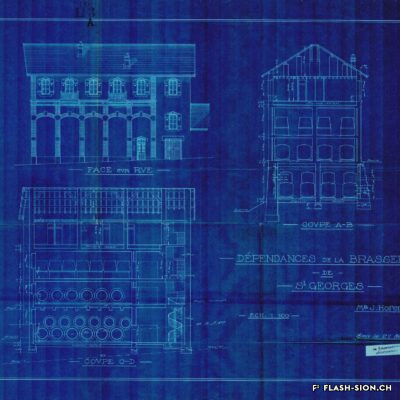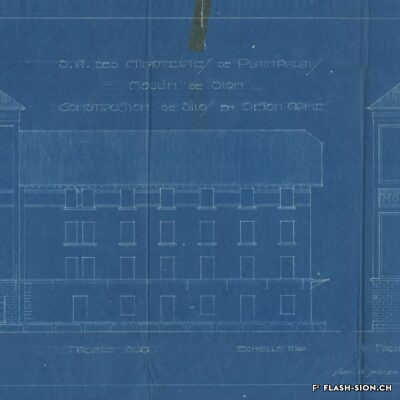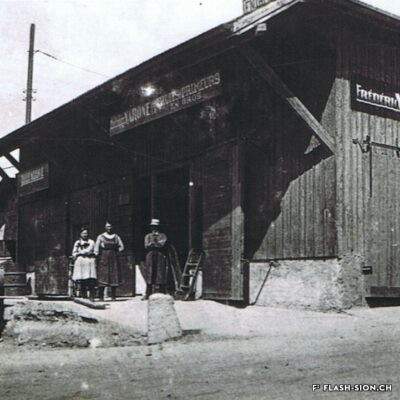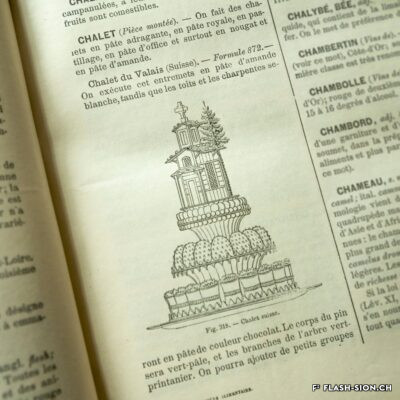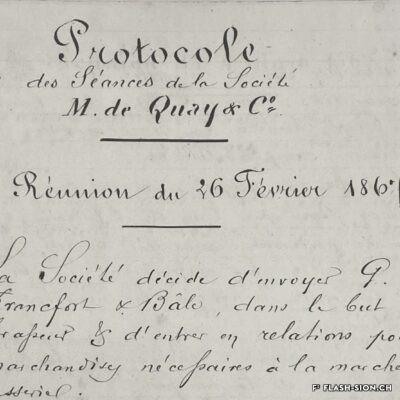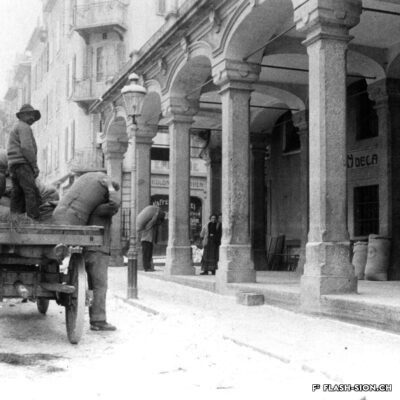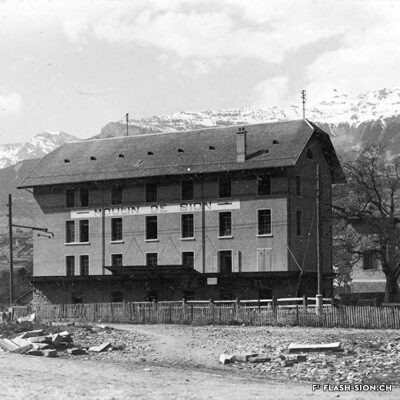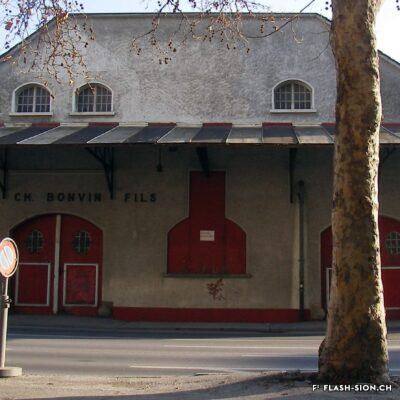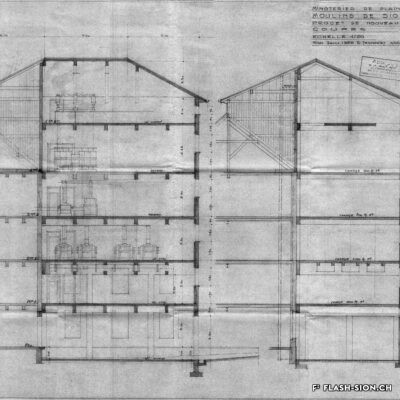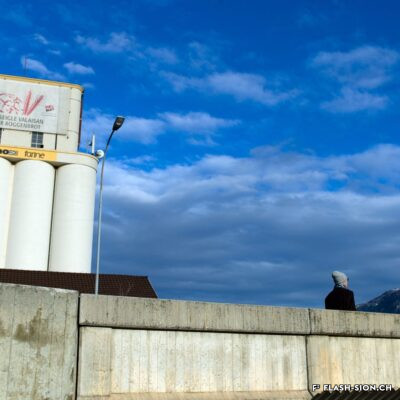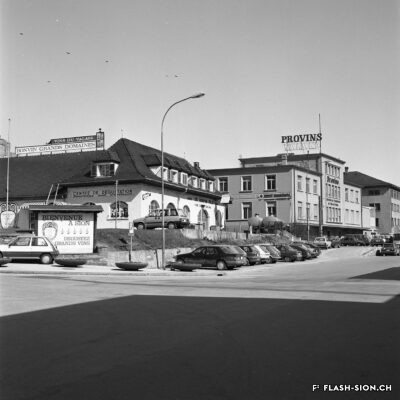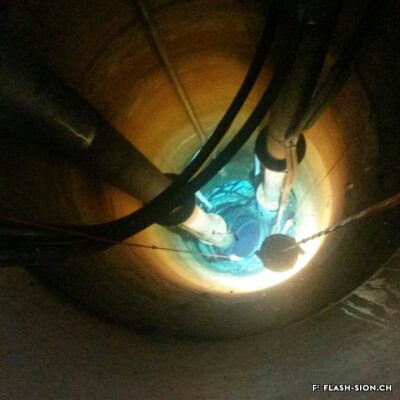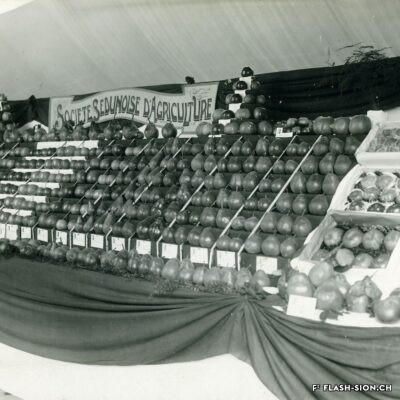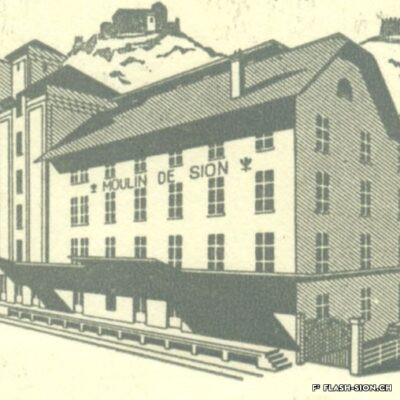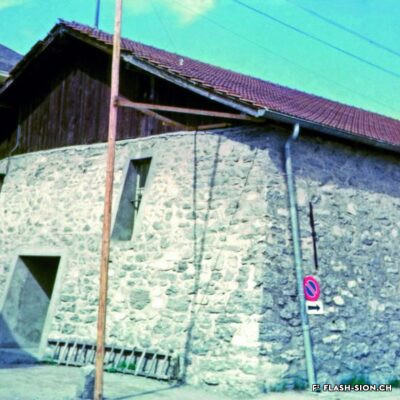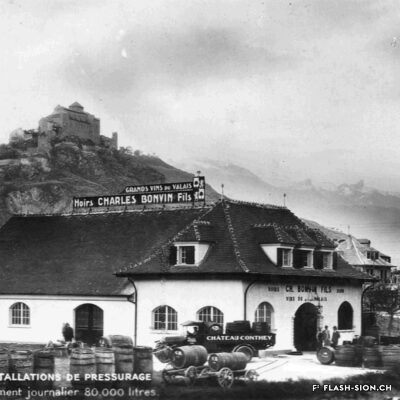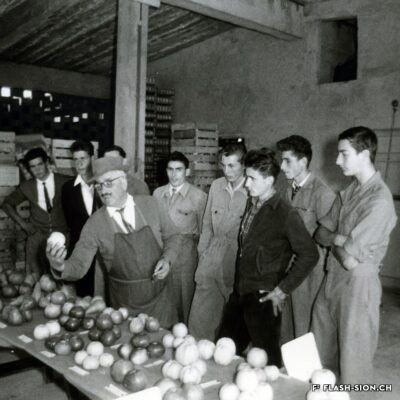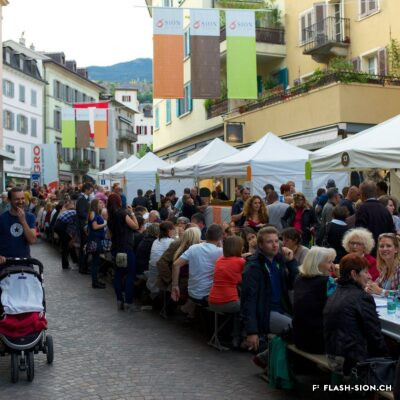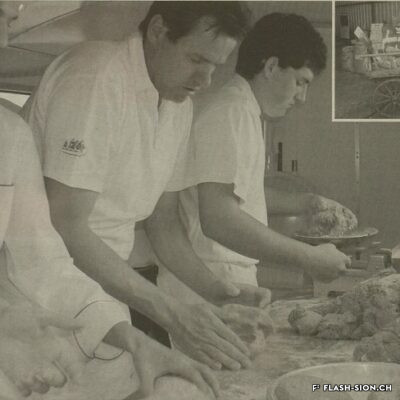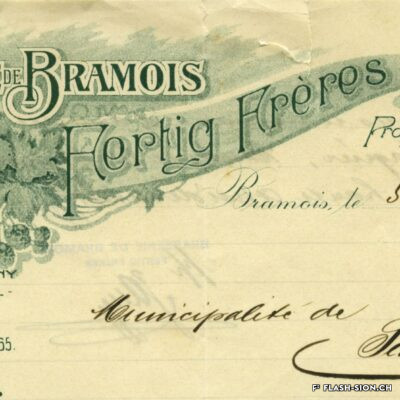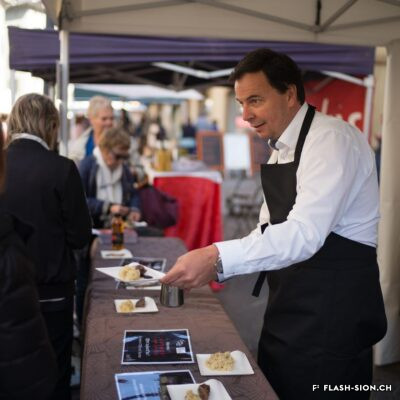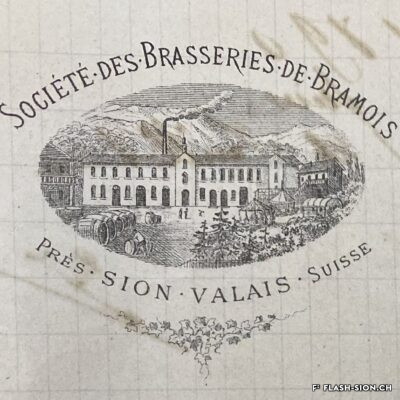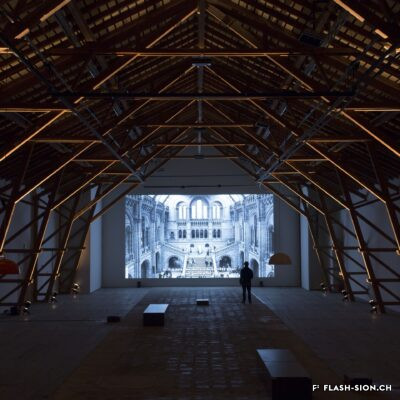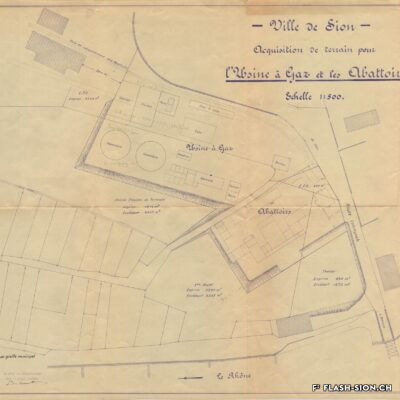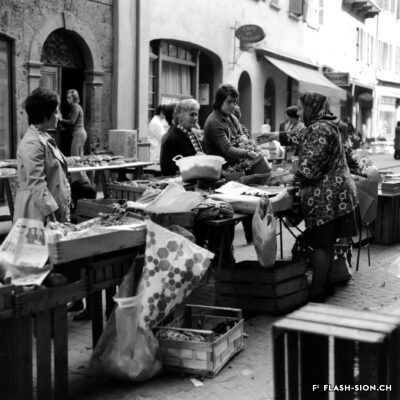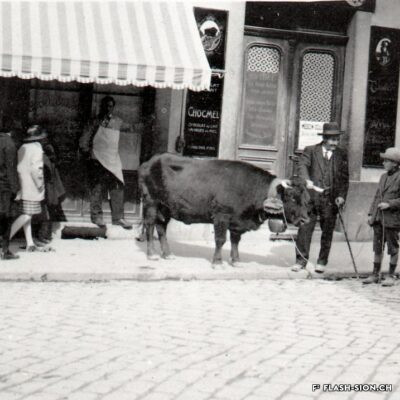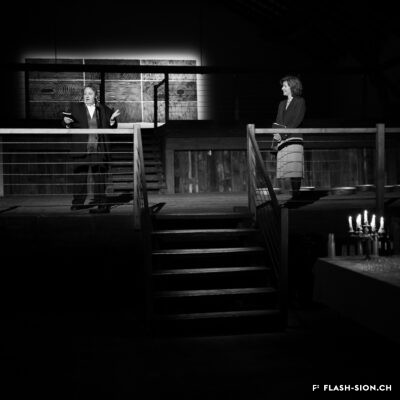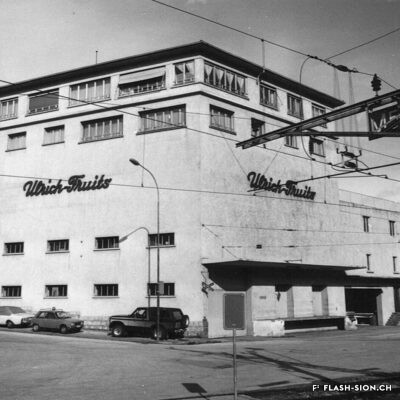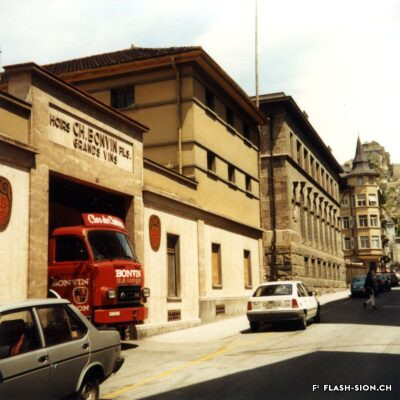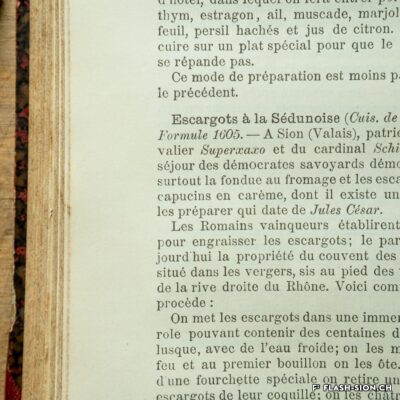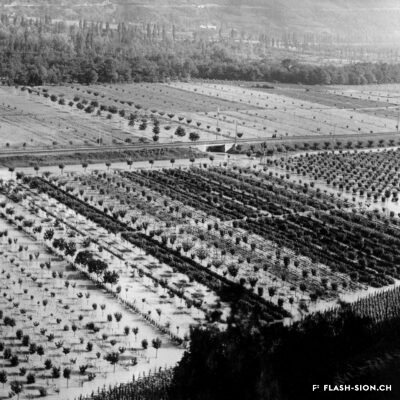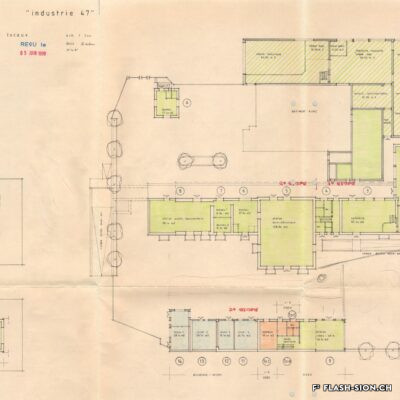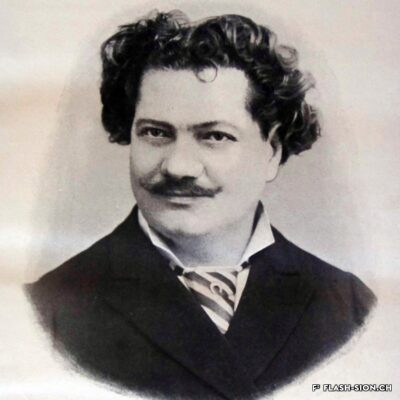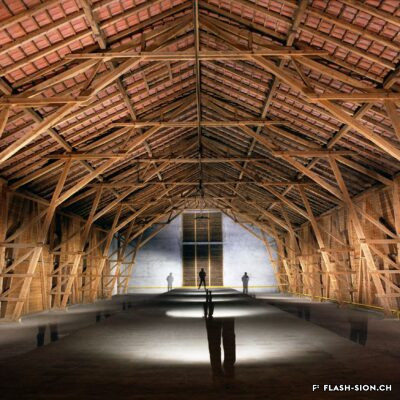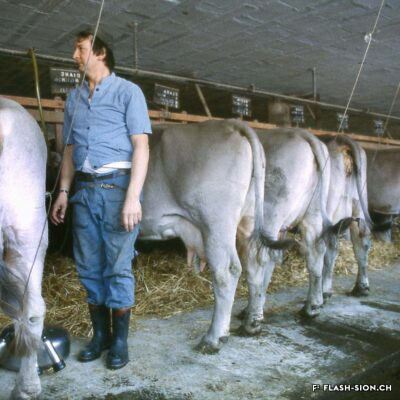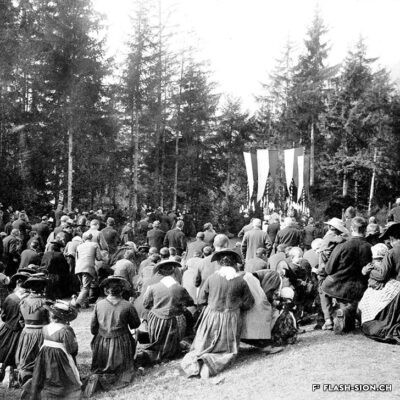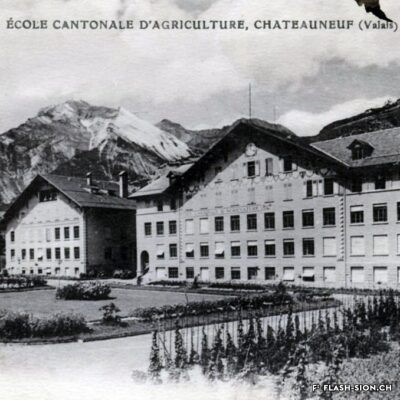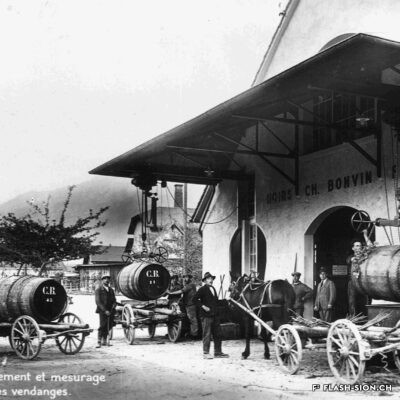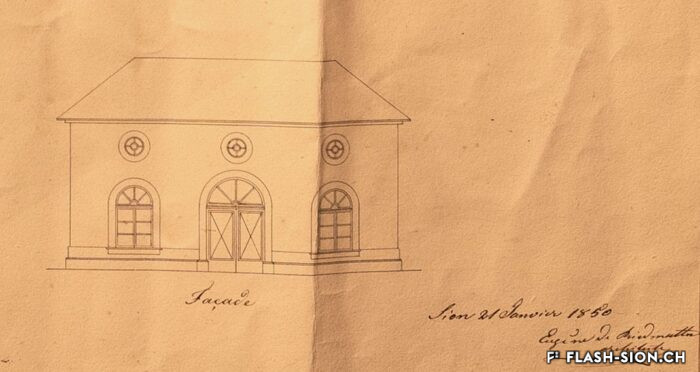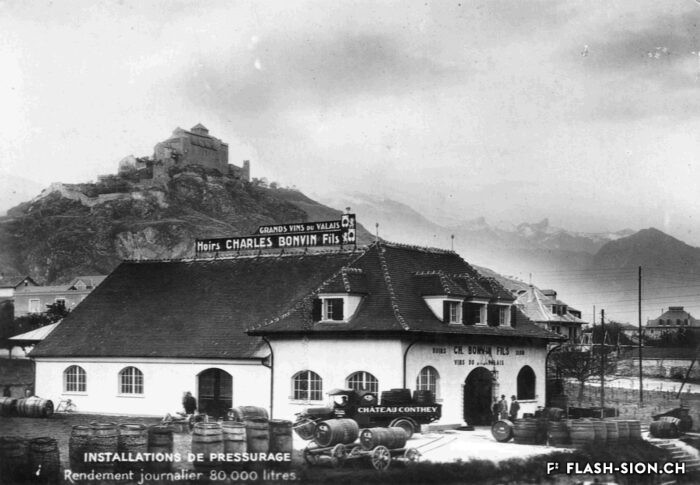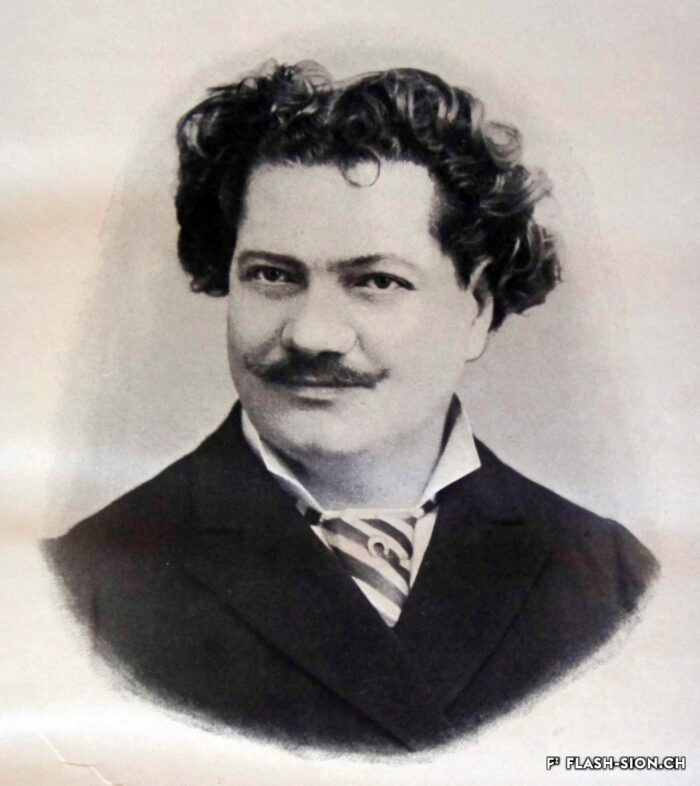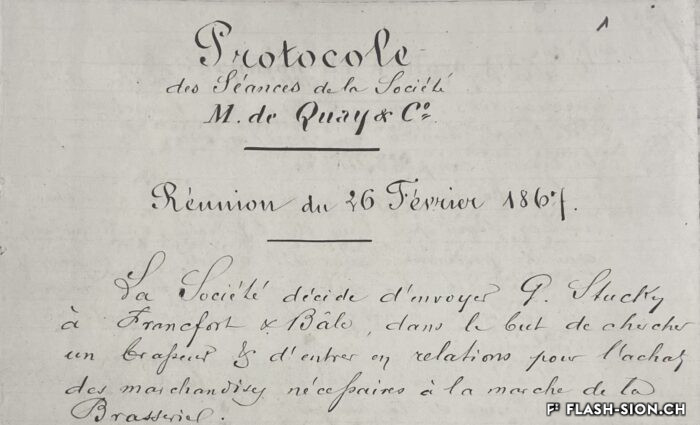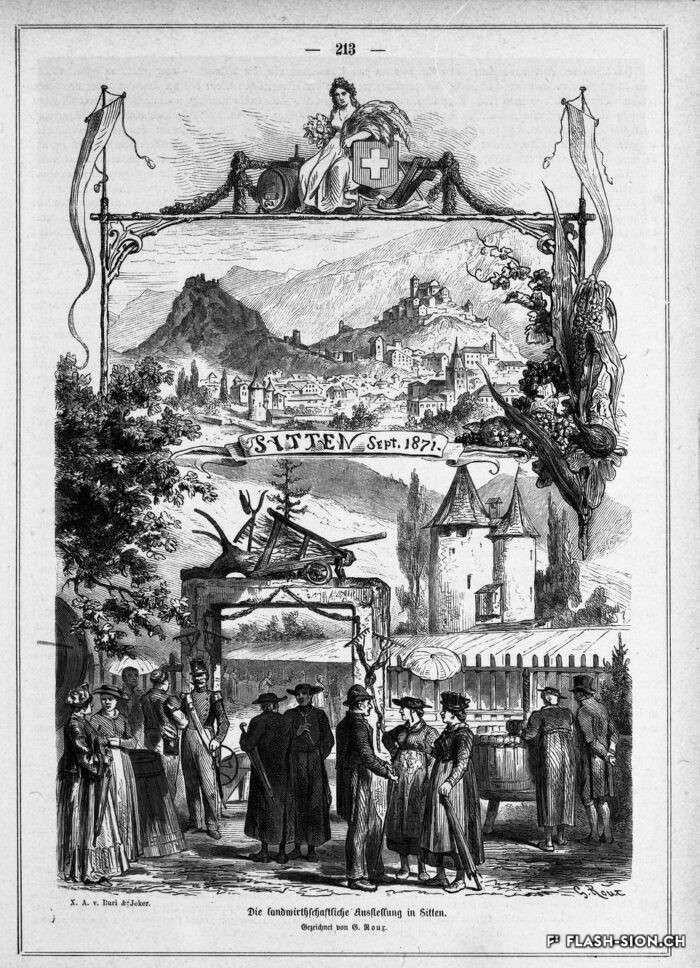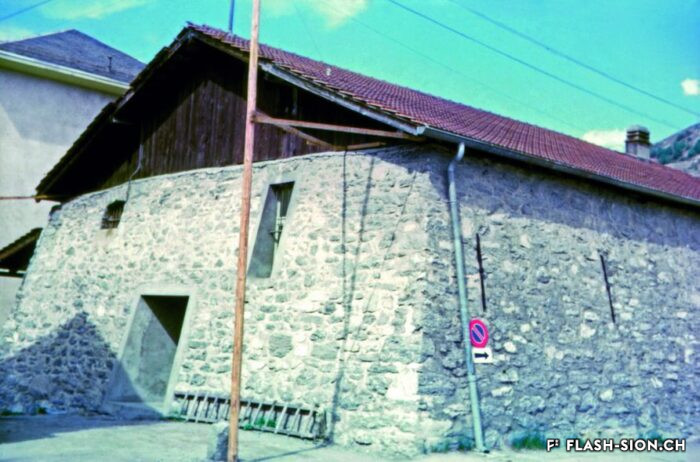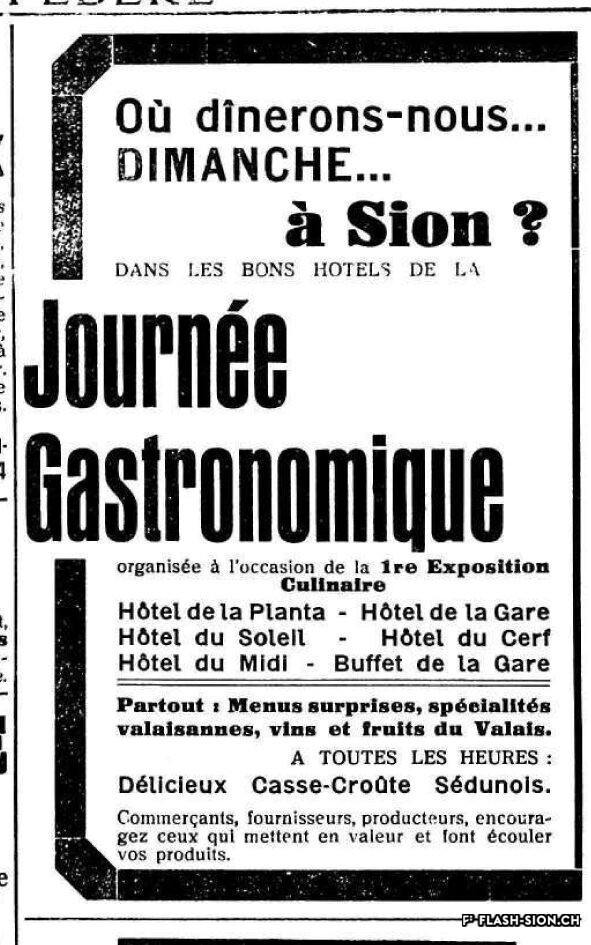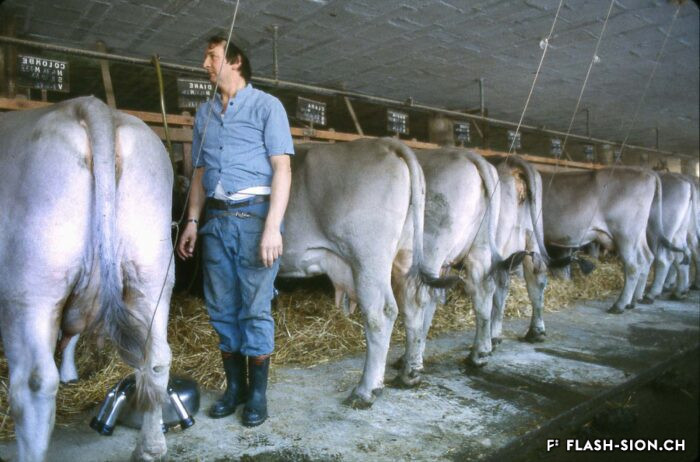D’un abattoir à l’autre
En 1850, des abattoirs municipaux sont construits sous le rocher de la Majorie, dans un quartier encore peu habité à l’époque. Avec l’augmentation de la population, ces locaux ne répondent plus aux normes d’hygiène dès le début du 20e siècle. Les discussions pour un nouveau bâtiment commencent. Durant les années 1930, les abattoirs déménagent à la rue de l’Industrie, lieu plus approprié. Ils y resteront près de 70 ans avant de devoir fermer, n’étant plus assez rentables. L’édifice est ensuite investi par l’Œuvre suisse d’entraide ouvrière (OSEO), le Service des sports, de la jeunesse et des loisirs ainsi que certaines sociétés locales. Le départ de l’OSEO, début 2021, offre à la Ville la possibilité d’en faire un lieu dédié à la créativité et à l’innovation au cœur du quartier Ronquoz 21.
Von einem Schlachthof zum andern
1850 wird am Fusse des Majoria-Felsens in einem damals noch kaum bebauten Quartier ein erster städtischer Schlachthof errichtet. Dieser entspricht aufgrund des grossen Bevölkerungszuwachses bereits ab anfangs des 20. Jahrhunderts nicht mehr den Hygienenormen. Es folgen längere Verhandlungen, um einen neuen und geeigneteren Standort zu finden. In den 1930er Jahren siedelt der Schlachthof an die Rue de l’Industrie über, wird während 70 Jahren betrieben und dann aufgrund ungenügender Rentabilität geschlossen. Das Gebäude wird darauf von dem Schweizerischen Arbeitshilfswerk (SAH), dem städtischen Amt für Sport, Jugend und Freizeit wie auch lokalen Vereinen genutzt. Der Auszug des SAH eröffnet der Stadt schliesslich die Chance, mitten im Quartier von Ronquoz 21 einen Ort für Kreativität und Innovation anzusiedeln.
From one slaughterhouse to another
In 1850, municipal slaughterhouses were built under the Majorie rock, in a neighbourhood that was not very populated at the time. With the increase in population at the beginning of the 20th century, these premises no longer met hygiene standards. Discussions about a new building began. During the 1930s, the slaughterhouses moved to the ‘Rue de l’Industrie’, a more suitable location. They remained there for almost 70 years before being forced to close as they were no longer profitable. The building was then taken over by the Swiss Labour Assistance (OSEO, Œuvre suisse d’entraide ouvrière), the Sports, Youth and Leisure Service (Service des sports, de la jeunesse et des loisirs) and some local societies. The departure of the OSEO, at the beginning of 2021, offered the city the possibility of turning it into a venue dedicated to creativity and innovation in the heart of the Ronquoz 21 district.
Da un macello all’altro
Nel 1850 furono costruiti dei macelli comunali sotto la roccia di Majorie, in un quartiere che all’epoca era poco popolato. Con l’aumento della popolazione, all’inizio del XX secolo questi locali non soddisfacevano più gli standard igienici. Sono così iniziate le discussioni per la costruzione di un nuovo edificio. Negli anni ’30 i macelli si trasferirono nella Rue de l’Industrie, in una posizione più adatta. L’azienda rimase lì per quasi 70 anni prima di essere costretta a chiudere non essendo più abbastanza redditizia. L’edificio è stato poi preso in gestione dall’OSEO (Soccorso Operaio Svizzero,SOS), il Service des sports, de la jeunesse et des loisirs (Servizio dello sport, della gioventù e del tempo libero) e da alcune società locali. La partenza del OSEO, all’inizio del 2021, offre alla Città la possibilità di trasformarlo in un luogo dedicato alla creatività e all’innovazione nel cuore del distretto Ronquoz 21.
Charles et les caves festives
Fondée en 1858, la maison sédunoise des Hoirs Charles Bonvin Fils fait figure de pionnière en matière de commerce vinicole en Valais. Charles-Marie Bonvin, son fondateur, donne l’impulsion au domaine et fait connaître les vins valaisans hors du canton et de la Suisse. Son fils Charles (1858-1922) prend la relève et à sa suite, ses deux fils, Charles (1888-1937) puis Félix. Aux caves et bureaux de la rue des Vergers et de la rue des Remparts s’ajoutent en 1932, les pressoirs de l’avenue de Tourbillon, face à la gare. Ces derniers deviennent alors un centre moderne de pressurage et d’encavage, jusqu’au début des années 1990. Désaffectés pendant de nombreuses années, ces pressoirs à l’abandon attirent l’attention d’un collectif qui y voit un potentiel culturel et souhaite leur redonner vie de façon éphémère. En 2008 et durant une année, l’association « Les Caves à Charles » fait vibrer ce lieu industriel chargé d’histoire, pour lui rendre un dernier hommage avant sa démolition.
Charles und die festliche Kellerei
Die 1858 in Sitten gegründete Weinkellerei der Erben von Charles Bonvin und Söhne gilt als Pionierin des Weinhandels im Wallis. Charles-Marie Bonvin, Begründer des Hauses, verstand es, den Walliser Wein ausserhalb des Kantons und der Schweiz bekannt zu machen. Der Betrieb wird in der Folge von seinem Sohn Charles (1858-1922) übernommen bevor dessen Söhne Charles (1888-1937) und später Félix die Nachfolge antreten. Zum Weinkeller und den Büroräumlichkeiten in der Rue des Vergers und der Rue des Remparts gesellt sich 1932 das Gebäude mit Weinpresse an der Avenue de Tourbillon, direkt gegenüber dem Bahnhof. Dieses entwickelt sich bis anfangs der 1990er Jahre zu einer modernen Kelterei mit Weinkeller. Danach bleibt das Gebäude während einiger Jahre ungenutzt. 2008 interessiert sich ein Kollektiv für die Kelterei und sieht deren Potenzial für eine kurzfristige kulturelle Nutzung. Während einem Jahr bringt der Verein «Les Caves à Charles» den geschichtsträchtigen Ort nochmals zum Schwingen und erweist ihm, bevor er abgebrochen wird, die letzte Ehre.
Charles and the festive wine cellars
Founded in 1858, the Sion-based company of Hoirs Charles Bonvin Fils is a pioneer in the wine trade in Valais. Charles-Marie Bonvin, its founder, provided the impetus to the estate and made Valais wines known outside the canton and Switzerland. His son Charles (1858-1922) took over and was followed by his two sons, Charles (1888-1937) and Félix. In 1932, the cellars and offices in the ‘Rue des Vergers’ and the ‘Rue des Remparts’ were completed by the addition of wine presses in the ‘Avenue de Tourbillon’, opposite the railway station. They became a modern pressing and cellaring centre until the early 1990s. Disused for many years, these abandoned wine presses attracted the attention of a group who saw a cultural potential in them and wanted to bring them back to life in a temporary way. In 2008 and for one year, the Charles Cellars Association (Les Caves à Charles) filled this industrial site, full of history, with life and paid it a last tribute before its demolition.
Charles e le cantine in festa
Fondata nel 1858, l’azienda sedunese Hoirs Charles Bonvin Fils, è una pioniera del commercio di vino nel Vallese. Charles-Marie Bonvin, il suo fondatore, diede impulso alla tenuta e fece conoscere i vini del Vallese al di fuori del cantone e della Svizzera. Il figlio Charles (1858-1922) prese il testimone e fu seguito dai suoi due figli, Charles (1888-1937) e Félix. Nel 1932, alle cantine e agli uffici nella Rue des Vergers e nella Rue des Remparts si aggiunsero i torchi di Avenue de Tourbillon, di fronte alla stazione. In seguito, fino all’inizio degli anni Novanta, si sono trasformati in un moderno centro di pressatura e cantina. In disuso da molti anni, questi torchi abbandonati hanno attirato l’attenzione di un gruppo che ha visto in essi un potenziale culturale e ha voluto riportarli in vita in modo temporaneo. Nel 2008 e per un anno, l’associazione “Les Caves à Charles” (Le cantine di Charles) ha riportato in vita questo luogo industriale ricco di storia, per rendergli un ultimo omaggio prima della sua demolizione.
Un cuisinier avant-gardiste
En matière de gastronomie, l’histoire a longtemps oublié un enfant du pays. Originaire de Vex, un certain Joseph Favre (1844-1903) s’illustre en tant que pionnier de la « science et de l’hygiène culinaire ». Après un apprentissage de trois ans, vraisemblablement à l’Hôtel de la Poste, à l’époque l’un des plus prestigieux hôtels de Sion, il sillonne la Suisse et l’Europe pour parfaire son art. Anarchiste à ses heures, Joseph Favre se fait surtout connaître par son acharnement à rendre à la cuisine ses lettres de noblesse. Il publie notamment dès 1877 le premier journal de cuisine écrit par des cuisiniers et participe aux premiers concours et expositions culinaires. Dès 1883, ce théoricien progressiste consacre sa vie à la rédaction de son monumental « Dictionnaire universel de cuisine pratique et d’hygiène alimentaire ». Il est également à l’origine de la fondation de l’Académie culinaire de France en 1883.
Ein fortschrittlicher Koch
Im Bereich der Gastronomie blieb der Walliser Joseph Favre (1844-1903) der breiten Öffentlichkeit lange unbekannt. Der aus Vex stammende Koch hat sich als Pionier der Kulinarik und wissenschaftlichen Küchenhygiene bekannt gemacht. Nach einer dreijährigen Lehre, vermutlich im damals renommierten Hotel Post in Sitten, bereist er die Schweiz und Europa und erweitert seine Kochkunst. Kurze Zeit einer anarchistischen Bewegung verschrieben, zeichnet sich Favre insbesondere durch sein hartnäckiges Engagement für eine moderne Ess- und Kochkultur aus. Ab 1877 veröffentlicht er die erste, von einem Koch verfasste Kochzeitschrift und nimmt an ersten Kochwettbewerben und kulinarischen Ausstellungen teil. Ab 1883 widmet sich der fortschrittliche Theoretiker ganz dem Verfassen seines bedeutendsten Werkes, dem «Universallexikon des Kochens und der Lebensmittelhygiene». Er ist ebenfalls Begründer der 1883 entstandenen «Académie culinaire de France».
An avant-garde cook
When it comes to gastronomy, history has long forgotten a local youngster. Originally from Vex, a certain Joseph Favre (1844-1903) distinguished himself as a pioneer of “culinary science and hygiene”. After a three-year apprenticeship, probably at the Hôtel de la Poste, which was one of the most prestigious hotels in Sion at the time, he travelled throughout Switzerland and Europe to perfect his art. An anarchist at times, Joseph Favre is best known for his determination to give nobility back to cuisine. In 1877, he published the first cooking journal written by cooks and he took part in the first culinary competitions and exhibitions. From 1883, this progressive theorist devoted his life to writing his monumental “Universal Dictionary of Practical Cooking and Food Hygiene”. He was also a founder of the French Culinary Academy in 1883.
Un cuoco d’avanguardia
Quando si parla di gastronomia, la storia ha dimenticato da tempo un ragazzo del posto. Originario di Vex, un certo Joseph Favre (1844-1903) si distinse come pioniere della “scienza e dell’igiene culinaria”. Dopo un apprendistato di tre anni, probabilmente presso l’Hôtel de la Poste, all’epoca uno degli alberghi più prestigiosi di Sion, viaggiò in tutta la Svizzera e in Europa per perfezionare la sua arte. A volte anarchico, Joseph Favre è noto soprattutto per la sua determinazione a dare alla cucina le sue lettere di nobiltà. Nel 1877 pubblicò il primo giornale di cucina scritto da cuochi e partecipò ai primi concorsi e mostre culinarie. A partire dal 1883, questo teorico progressista si dedicò alla stesura del suo monumentale “Dictionnaire universel de cuisine pratique et d’hygiène alimentaire”. A lui si deve anche la fondazione dell’Accademia culinaria francese nel 1883.
De la bière au pays du vin
Il aura fallu du temps pour que la bière s’impose en Valais, pays du vin par excellence. Malgré l’interdiction de ce « breuvage inhabituel » en 1802 par les autorités valaisannes, plusieurs brasseries s’installent dans la région sédunoise au cours du 19e siècle. En 1865, Maurice de Quay, pharmacien hollandais, en ouvre une au nord de la ville de Sion. A la même période environ, la brasserie Koebel, Aymon et Cie est également active à Bramois. Pour produire une bière de qualité, les deux entreprises recrutent leurs employés en Suisse allemande, voire en Allemagne. Vers la fin du 19e siècle, la brasserie de Quay est reprise par Johan Hofer et celle de Bramois passe aux mains des frères Fertig. En 1926, elles fusionnent pour devenir la Brasserie Valaisanne telle qu’on la connait aujourd’hui. Dès 1950, l’entreprise s’industrialise avec, notamment, des installations frigorifiques qui remplacent la glacière.
Vom Bier zum Weinland
Es ging eine ganze Weile, bis sich das Bier in dem vom Weinbau geprägten Wallis durchsetzt. Obwohl die Walliser Behörden das «ungewohnte Gebräu» verbieten, siedeln sich im Laufe des 19. Jahrhunderts mehrere Bierbrauereien in der Region Sitten an. 1865 eröffnet der holländische Apotheker Maurice de Quay im Norden der Stadt Sitten eine Brauerei. Etwa zur gleichen Zeit wird bei Koebel, Aymon et Cie in Bramois ebenfalls Bier gebraut. Zur Herstellung eines hochwertigen Bieres, heuern beide Unternehmen ihre Mitarbeiter in der Deutschschweiz oder gar in Deutschland an. Ende des 19. Jahrhunderts wird die Brauerei de Quay von Johan Hofer übernommen und die Brauerei in Bramois geht in den Besitz der Gebrüder Fertig über. 1926 fusionieren die beiden Unternehmen unter dem Namen Walliser Brauerei, welche bis heute noch besteht. Ab den 1950er Jahren wird die Produktion unter anderem durch die Installation von Kühlanlagen industrialisiert, die den Eiskeller ersetzen.
Beer in wine country
It took a long time for brewing beer to become established in Valais, a wine country par excellence. Despite the ban on this “unusual beverage” in 1802 by the Valais authorities, several breweries were set up in the Sion region during the 19th century. In 1865, Maurice de Quay, a Dutch pharmacist, opened one in the northern part of the city of Sion. Around the same time, the brewery Koebel, Aymon & Cie was also active in Bramois. In order to produce quality beer, both companies recruited their employees in German-speaking Switzerland, and even in Germany. Towards the end of the 19th century, the Quay brewery was taken over by Johan Hofer and the Bramois brewery was taken over by the Fertig brothers. In 1926, they merged to become the Brasserie Valaisanne as we know it today. From 1950 onwards, the company became more industrial, with refrigeration facilities replacing the icebox.
La birra nel paese del vino
Ci è voluto molto tempo affinché la birra si affermasse in Vallese, la terra del vino per eccellenza. Nonostante il divieto di questa “bevanda insolita” nel 1802 da parte delle autorità vallesane, nel corso del XIX secolo nella regione sedunese sono state aperte diverse birrerie. Nel 1865, Maurice de Quay, un farmacista olandese, aprì una fabbrica di birra a nord della città di Sion.
All’incirca nello stesso periodo, anche la birreria Koebel, Aymon et Cie era attiva a Bramois. Per produrre birra di qualità, entrambe le aziende reclutarono i propri dipendenti dalla Svizzera tedesca e persino dalla Germania. Verso la fine del XIX secolo, il birrificio Quay fu rilevato da Johan Hofer e il birrificio di Bramois dai fratelli Fertig. Nel 1926 si fusero per diventare la Brasserie Valaisanne come la conosciamo oggi. Dal 1950 in poi, l’azienda divenne più industriale, con impianti di refrigerazione che sostituirono la ghiacciaia.
Pomme de Reinette et pomme d’Api
Contrairement à ce que pourrait suggérer son nom, la Reinette (monstrueuse) du Canada a ses origines en France. Elle est décrite pour la première fois en 1771 par le botaniste du Roi, Pierre Andrieux. Son introduction dans les vergers valaisans coïncide avec la première correction du Rhône (1863-1894). Les terres gagnées par l’assèchement de la plaine offrent en effet un terroir particulièrement propice à sa culture. Dès la fin du 19e siècle, la pomme Canada devient la variété emblématique des vergers et pré-vergers à hautes tiges de Bramois, d’où elle était exportée jusque dans la capitale française. Aujourd’hui, les vergers de Sion et de Vex sont dans les derniers en Suisse où cette variété ancienne est encore présente et replantée, notamment sur les terrains de la Bourgeoisie de Sion. Celle-ci offre chaque automne une cagette de ces pommes aux bourgeois. Pomme de garde par excellence, la Canada est tout particulièrement appréciée pour sa chair fondante et la saveur douce et acidulée de son jus.
In meinem kleinen Apfel…
Anders als es der Name vermuten lässt, hat die Kanada-Reinette ihren Ursprung in Frankreich. Sie wird erstmals 1771 von dem königlichen Botaniker Pierre Andrieux beschrieben. Die Einführung der Apfelsorte im Wallis fällt mit der ersten Rhonekorrektur (1863-1894) zusammen. Die Trockenlegung der Rhoneebene bietet einen besonders geeigneten Boden für den Anbau der Apfelsorte. Ab Ende des 19. Jahrhunderts entwickelt sich die Kanada-Reinette zur emblematischen Apfelsorte der Hochstamm und Wiesenobstgärten von Bramois und wird bis nach Paris exportiert. Heute ist diese alte Apfelsorte in der Schweiz insbesondere noch in den Obstgärten von Sitten und Vex anzutreffen und wird nicht zuletzt auf den Grundstücken der Burgergemeinde von Sitten neu angepflanzt. Jeden Herbst verteilt diese ihren Burgern eine Kiste Kanada-Reinetten. Als Lagerapfel beliebt, wird das Tafelobst ganz besonders für sein zart-schmelzendes Fruchtfleisch und den süss-säuerlichen Geschmack seines Saftes geschätzt.
Reinette apple and an Api apple (a children’s song)
Contrary to what its name might suggest, the Reinette (Monstrueuse) of Canada has its origins in France. It was first described in 1771 by the King’s botanist, Pierre Andrieux. Its introduction into Valais orchards coincided with the first correction of the Rhône River (1863-1894). The land obtained by the draining of the plain offered a particularly favourable soil for the cultivation of this variety. From the end of the 19th century, the Canada apple became the emblematic variety of orchards and orchard meadows of Bramois, from where it was exported all the way to the French capital. Today, the orchards of Sion and Vex are some of the only ones in Switzerland where this old variety is still present and replanted, notably on the grounds belonging to the Bourgeoisie of Sion. Every autumn, the Bourgeoisie offers a crate of these apples to its members. The Canada apple is particularly appreciated for its melt-in-the-mouth flesh and the sweet, tangy taste of its juice.
« Pomme de Reinette e pomme d’Api »
Contrariamente a quanto potrebbe far pensare il nome, la Reinette (mostruosa) del Canada ha origini francesi. Fu descritta per la prima volta nel 1771 dal botanico del re, Pierre Andrieux. La sua introduzione nei frutteti vallesani coincise con la prima correzione del Rodano (1863-1894).
I terreni bonificati dal drenaggio della pianura offrivano un terreno particolarmente favorevole alla sua coltivazione. Dalla fine del XIX secolo, la mela Canada divenne la varietà emblematica dei frutteti e dei pre-frutteti ad alto fusto di Bramois, da dove veniva esportata nella capitale francese.
Oggi i frutteti di Sion e Vex sono gli unici in Svizzera in cui questa vecchia varietà è ancora presente e viene ripiantata, in particolare nei terreni del patriziato di Sion. Ogni autunno, quest’ultimo offre una cassa di queste mele ai suoi patrizi. La Canada è la mela per eccellenza, particolarmente apprezzata per la sua polpa fondente e per il sapore dolce e acidulo del suo succo.
De la source au robinet
A la fin du 19e siècle, les multiples réclamations quant à la qualité et à la quantité de l’eau potable des fontaines forcent la Municipalité à réagir. En 1895, elle confie l’exécution d’un réseau d’eau potable relié à un grand réservoir à Platta à l’entreprise Dumont&fils. Cependant, les installations mises en service dès 1897, se révèlent non-conformes à plusieurs titres. Ainsi, les autorités reconsidèrent le captage des sources de la Fille et des Fontannées inauguré en 1901. Depuis, l’augmentation constante de la consommation d’eau contraint les services industriels de la Ville à trouver sans relâche de nouvelles sources d’approvisionnement. Dès 1931, le puits de Sainte-Marguerite pare aux cas d’urgence et, en 1951 et 1964, le deuxième et troisième réservoir de Tourbillon sont mis en service. Aujourd’hui, la mise en valeur de cette ressource fragile et la sensibilisation de la population à une consommation responsable représentent plus que jamais les défis de demain.
Von der Quelle zum Wasserhahn
Ende des 19. Jahrhunderts zwingen zahlreiche Beschwerden, welche Qualität und Menge des Trinkwassers in den Brunnen bemängeln, die Stadtverwaltung zum Handeln. Letztere beauftragt 1895 das Unternehmen Dumont&Söhne mit der Planung einer zentralen Wasserversorgung, zu welcher ebenfalls das Reservoir in Platta zählt. Die 1897 in Betrieb genommene Anlage erweist sich jedoch von Anfang an und in verschiedenen Punkten als nicht konform. Die Fassung der Quellen «de la Fille» und «des Fontanées» wird daher durch die Stadtbehörden wiedererwägt und 1901 eingeweiht. Seither verpflichtet der stetig steigende Trinkwasserverbrauch die Stadtwerke, immer neue Wasserquellen zu erschliessen. Ab 1931 beugt das Grundwasserpumpwerk von Sainte-Marguerite Notsituationen vor, 1951 und 1964 werden das zweite und das dritte Reservoir in Tourbillon in Betrieb genommen. Heute stellen die Erschliessung dieser lebenswichtigen Ressource und die Sensibilisierung der Bevölkerung für einen verantwortungsvollen Verbrauch mehr denn je eine Herausforderung für die Zukunft dar.
From source to tap
At the end of the 19th century, the numerous complaints about the quality and quantity of the drinking water from the fountains forced the Municipality to react. In 1895, it appointed the Dumont&fils company to execute the construction of a drinking water network connected to a large reservoir in Platta. However, the installations put into service in 1897 proved to be non-compliant in several respects. Thus, the authorities reconsidered the catchment of the Fille and Fontannées springs, which were inaugurated in 1901. The constant increase in water consumption forced the city’s industrial services to find new sources of supply. From 1931, the Sainte-Marguerite well was used for emergencies and, in 1951 and 1964, the second and third Tourbillon reservoirs were put into service respectively. Today, the development of this fragile resource and the raising of public awareness about responsible consumption are more than ever the challenges of tomorrow.
Dalla sorgente al rubinetto
Alla fine del XIX secolo, le numerose lamentele per la qualità e la quantità dell’acqua potabile delle fontane costrinsero il comune a reagire. Nel 1895, affidò la costruzione di una rete di acqua potabile collegata a un grande serbatoio a Platta alla società Dumont&fils. Tuttavia, gli impianti messi in servizio nel 1897 si rivelarono non conformi sotto diversi aspetti. Le autorità quindi riconsiderarono il bacino di raccolta delle sorgenti Fille e Fontannées, inaugurate nel 1901. Da allora, il costante aumento del consumo di acqua ha costretto i servizi industriali della città a trovare nuove fonti di approvvigionamento. Dal 1931, il pozzo di Sainte-Marguerite fu utilizzato per le emergenze e, nel 1951 e nel 1964, furono messi in funzione il secondo e il terzo serbatoio di Tourbillon. Oggi, lo sviluppo di questa fragile risorsa e la sensibilizzazione della popolazione a un consumo responsabile sono più che mai le sfide del domani.
Un moulin à la pointe
Après une tentative infructueuse à l’aube du 20e siècle, les Minoteries de Plainpalais (Genève) ouvrent une succursale à Sion en 1919. Le Moulin de Sion, entreprise d’importance pour le développement économique du Valais, s’agrandit rapidement. Les premiers silos en béton armé sont construits en 1925. Un peu moins de 15 ans plus tard, il faut en édifier d’autres. Le complexe continue de s’étendre jusqu’en 1980. Au fil du temps, les techniques évoluent et, dès 1984, les opérations sont entièrement automatisées. Le Moulin de Sion est alors un des plus modernes d’Europe ! Suite à l’obtention du label AOC pour le pain de seigle – premier pain d’Europe à le recevoir –, le Moulin de Sion se consacre entièrement à la fabrication de la farine de seigle. En 2015, la production est déplacée à Naters et le bâtiment peut alors être totalement réaffecté. Tout en conservant son apparence extérieure, les lieux accueillent désormais restaurants, fitness, bureaux et appartements notamment.
Modernste Mühlentechnik
Nach einem erfolglosen Niederlassungsversuch zu Beginn des 20. Jahrhunderts eröffnen die Minoteries de Plainpalais (Genf) schliesslich 1919 eine Zweigstelle in Sitten. Die Mühle von Sitten nimmt in der wirtschaftlichen Entwicklung des Wallis eine wichtige Stellung ein und wird schon nach kurzer Zeit ausgebaut. 1925 entstehen die ersten Silos aus Stahlbeton. Nur knapp 15 Jahre später, werden weitere Silos erstellt. Bis 1980 wird der Mühlenkomplex kontinuierlich erweitert und die Mühlentechnik modernisiert. Ab 1984 wird der Betrieb schliesslich vollständig automatisiert. Die Mühle Sitten zählt zu dieser Zeit zu einem der modernsten Betriebe Europas! Nach dem Eintrag des Walliser Roggenbrotes ins Register der Ursprungsbezeichnung (GUB) – das erste Brot in Europa mit dieser Bezeichnung – widmet sich die Mühle Sitten ganz der Herstellung von Roggenmehl. 2015 wird die Produktion nach Naters verlegt und die Industriebrache wird vollständig umgenutzt. Das äussere Erscheinungsbild der Mühle bleibt erhalten, der Gebäudekomplex beherbergt jedoch neu verschiedene Restaurants, ein Fitnesscenter, Büroräumlichkeiten und moderne Wohnungen.
A mill at the forefront
After an unsuccessful attempt at the beginning of the 20th century, the Minoteries de Plainpalais (Geneva) opened a branch in Sion in 1919. The Moulin de Sion (Mill of Sion), an important company for the economic development of Valais, expanded rapidly. The first reinforced concrete silos were built in 1925. A little less than 15 years later, others had to be built. The complex continued to expand until 1980. Over time, technologies evolved and, in 1984, operations were fully automated. The Moulin de Sion became one of the most modern in Europe! After obtaining the AOC (PDO) label for rye bread – the first bread in Europe to receive it – the Moulin de Sion devoted itself entirely to the production of rye flour. In 2015, production was moved to Naters and the building’s function was completely reassigned. While retaining its external appearance, the premises now house restaurants, fitness centres, offices and flats, among other things.
Un mulino all’avanguardia
Dopo un tentativo fallito all’inizio del XX secolo, i mulini di Plainpalais (Ginevra) aprirono una filiale a Sion nel 1919. Il Moulin de Sion, un’azienda importante per lo sviluppo economico del Vallese, si espanse rapidamente. I primi silos in cemento armato furono costruiti nel 1925. Poco meno di 15 anni dopo, è stato necessario costruirne altri. Il complesso continuò ad espandersi fino al 1980. Nel corso del tempo, le tecniche si sono evolute e, a partire dal 1984, le operazioni sono state completamente automatizzate. Il Moulin de Sion è diventato così uno dei più moderni d’Europa! Dopo aver ottenuto il marchio AOC per il pane di segale – il primo pane in Europa a riceverlo – il Moulin de Sion si è dedicato interamente alla produzione di farina di segale. Nel 2015 la produzione si è spostata a Naters e l’edificio ha potuto essere completamente riutilizzato. Pur mantenendo il suo aspetto esterno, i locali ospitano oggi, tra l’altro, ristoranti, centri fitness, uffici e appartamenti.
Sion, la gourmande
Le 17 novembre 1935, les salons de l’Hôtel de la Planta accueillent la première exposition et concours d’art culinaire du Valais. Si la mise en valeur des produits du pays et l’art culinaire sont représentés lors de fêtes des vignerons, il faudra cependant attendre 1973 pour voir s’organiser, à Sierre, un autre concours culinaire. A cette occasion, un membre du jury souligne déjà à quel point l’art du bien manger est en train de se perdre. L’avènement du fast-food et l’industrialisation de la filière alimentaire renforcent encore ce constat qui conduit à l’organisation de la première semaine romande du goût en 2001. Sion participe à la manifestation annuelle dès 2003 et est d’emblée élue ville du goût. Forte de cette expérience et pouvant compter sur des acteurs locaux enthousiastes, la nouvelle politique touristique adoptée dès 2007 positionne Sion comme ville du goût. Depuis, la ville étoffe son offre touristique autour du label « Sion terroir urbain ».
Sitten, die Genüssliche
Am 17. November 1935 findet in den Sälen des Hotels de la Planta die erste kulinarische Ausstellung des Wallis mit Kochwettbewerb statt. Obwohl Winzerfeste darauf die regionalen Produkte und die Kochkunst des Wallis würdigen, kommt es erst 1973 in Sierre zu einem weiteren Kochwettbewerb. Bei dieser Gelegenheit spricht ein Jurymitglied bereits seine Besorgnis über den zunehmenden Verlust des guten Essens aus. In der Folge verstärken das Aufkommen von Fastfood und die Industrialisierung der Lebensmittelkette zusätzlich die Junkfood-Welle, die 2001 massgeblich zur Organisation der ersten Westschweizer Genusswoche führt. Sitten nimmt ab 2003 an dieser jährlichen Veranstaltung teil und wird auf Anhieb zur Genussstadt des Jahres gewählt. Diese positive Erfahrung und die Begeisterung der lokalen Akteure ermutigen die Behörden, über ihre neue Tourismuspolitik Sitten als Genussstadt zu positionieren. Seither baut die Stadt ihr touristisches Angebot rund um die Marke «Sion, terroir urbain» kontinuierlich aus.
Sion, city of food lovers
On November 17, 1935, the lounges of the Hôtel de la Planta hosted the first exhibition and competition of culinary art in the canton of Valais. Even though the promotion of the country’s products and the culinary art were present at the time of wine festivals, it was necessary to wait until 1973 to see another culinary contest being organised in Sierre. Already on that occasion, a jury member emphasized the degree to which the art of eating well was being lost. This observation was further reinforced by the arrival of fast food and the industrialisation of the food sector, resulting in the organisation of the first Week of Taste in French-Speaking Switzerland in 2001. Sion first took part in the annual event in 2003 and was immediately elected City of Taste. Benefiting from this experience and being able to count on enthusiastic local players, the new tourism policy, adopted in 2007, positioned Sion as a City of Taste. Since then, the city has been developing its tourism offer around the label “Sion urban terroir”.
Sion, la buongustaia
Il 17 novembre 1935, i saloni dell’Hôtel della Planta ospitarono la prima mostra e concorso di arte culinaria del Vallese. Sebbene la promozione dei prodotti locali e l’arte culinaria fossero presenti nelle feste del vino, solo nel 1973 è stato organizzato un altro concorso culinario a Sierre. In questa occasione, uno dei membri della giuria ha sottolineato quanto si stia perdendo l’arte di mangiar bene. L’avvento dei fast food e l’industrializzazione dell’industria alimentare hanno rafforzato ulteriormente questa osservazione, che ha portato all’organizzazione della prima Settimana del Gusto francofona nel 2001. Sion ha partecipato all’evento annuale dal 2003 ed è stata subito eletta città del gusto. Forte di questa esperienza e potendo contare su attori locali entusiasti, la nuova politica turistica adottata nel 2007 ha posizionato Sion come città del gusto. Da allora, la città ha sviluppato la sua offerta turistica attorno al marchio “Sion terroir urbain”.
De la ferme au centre culturel
La Ferme-Asile n’a pas toujours été le centre polyvalent dédié à l’art contemporain qu’il est aujourd’hui. Autrefois ferme de l’Hôpital-Asile, l’exploitation approvisionnait l’hôpital de Sion de 1955 à 1984. Laissé à l’abandon en pleine zone urbaine durant une dizaine d’années, ce témoin unique de l’activité agricole sédunoise des années 1950 suscite l’intérêt d’un groupe d’artistes, qui y voit l’opportunité de créer un lieu pluridisciplinaire vecteur de synergies culturelles. Ce centre artistique, nommé tout d’abord « Centre Culturel LézArt » voit le jour et se développe grâce à l’investissement d’artistes et de bénévoles. Depuis 1996, la bâtisse transformée abrite des ateliers d’artistes et un restaurant. Des expositions temporaires y sont régulièrement organisées. Au gré des financements et des agrandissements, l’établissement ouvre salle de concert, nouveaux espaces et ateliers supplémentaires. La rénovation de 2009 permet enfin l’utilisation sur toute l’année de la grange à la charpente impressionnante.
Vom Bauernhof zum Kulturzentrum
Heute widmet sich das vielseitige Zentrum der «Ferme-Asile» der zeitgenössischen Kunst – das war nicht immer so. Der ehemalige Bauernhof des Burgerspitals versorgte von 1955 bis 1984 das Krankenhaus von Sitten. Dieser einzigartige landwirtschaftliche Zeitzeuge der 1950er Jahre weckte das Interesse einer Gruppe von Kunstschaffenden, die hier einen multidisziplinären Ort einrichten wollten, um kulturelle Synergien zu nutzen. Das “Centre Culturel LézArt”, wie anfangs das Kulturzentrum genannt wurde, konnte nur dank grossem Engagement der beteiligten Kunstschaffenden und ehrenamtlicher Arbeit eröffnet werden. Seit 1996 beherbergen die umgebauten landwirtschaftlichen Gebäude Künstlerateliers und ein Restaurant. Es werden regelmässig Wechselausstellungen gezeigt. Durch weitere Finanzierungsmittel konnten im Laufe der Jahre ein Konzertsaal, neue Räumlichkeiten und zusätzliche Ateliers eröffnet werden. Die Renovation von 2009 ermöglicht nun die ganzjährige Nutzung der Scheune mit ihrem imposanten Dachstuhl.
From being a farm to becoming a cultural centre
The Ferme-Asile was not always the multi-purpose centre dedicated to contemporary art that it is today. Formerly the farm of the Hôpital-Asile, it supplied the hospital of Sion from 1955 to 1984. Left abandoned in the middle of an urban area for about ten years, this unique witness to the agricultural activity of Sion in the 1950s aroused the interest of a group of artists, who saw in it the opportunity to create a multi-disciplinary venue, a vector of cultural synergies. The artistic centre, initially named “Centre Culturel LézArt”, was born and developed thanks to the investment of artists and volunteers. Since 1996, the transformed building has housed artists’ studios and a restaurant. Temporary exhibitions are regularly held there. As funding was received and extensions were built, the establishment opened a concert hall, new rooms and additional workshops. The renovation in 2009 finally made it possible to use the barn with its impressive roof structure all year round.
Da fattoria a centro culturale
La Ferme-Asile non è sempre stata il centro polifunzionale dedicato all’arte contemporanea che è oggi. Un tempo fattoria dell’ospedale psichiatrico, ha rifornito l’ospedale di Sion dal 1955 al 1984. Abbandonata per dieci anni nel bel mezzo di un’area urbana, questa testimonianza unica dell’attività agricola sedunese negli anni Cinquanta ha suscitato l’interesse di un gruppo di artisti che hanno visto in essa l’opportunità di creare un luogo multidisciplinare, vettore di sinergie culturali. Questo centro artistico, inizialmente denominato “Centre Culturel LézArt”, è nato e si è sviluppato grazie all’investimento di artisti e volontari. Dal 1996, l’edificio trasformato ospita ateliers di artisti e un ristorante. Inoltre, vi si tengono regolarmente mostre temporanee. Grazie ai finanziamenti e agli ampliamenti, lo stabilimento ha aperto una sala concerti, nuovi spazi e ateliers. La ristrutturazione del 2009 ha finalmente consentito di utilizzare tutto l’anno il fienile con la sua imponente struttura del tetto.
La convivialité dans le panier
Dès le Moyen Age, les foires annuelles et concours de bétail animent la cité. Rythmant les saisons au gré des marchandises, les marchés des 19e et 20e siècles drainent un public varié et reconnectent la plaine à la montagne, ainsi que les clients aux producteurs et aux marchands. Qualité, prix et poids des marchandises sont contrôlés et les stands réglementés. Situé au cœur de la ville, le marché est alors un acteur principal de l’économie locale. Après un désintérêt progressif dès la seconde moitié du 20e siècle, le marché renaît en 2003, à l’initiative de l’Association des habitants de la vieille ville. Renouant avec la tradition, l’événement hebdomadaire très fréquenté atteste de sa grande attractivité. Devenu incontournable, le marché de la vieille ville s’affirme aujourd’hui comme lieu de rencontre et de convivialité.
Ein Marktkorb voller Geselligkeit
Seit dem Mittelalter beleben Jahrmärkte und Viehschauen die Stadt. Das rein saisonale Angebot auf den Wochenmärkten des 19. und 20. Jahrhunderts veranschaulicht den Lauf der Jahreszeiten, zieht ein vielfältiges Publikum an, verbindet die Seitentäler mit der Rhoneebene, sowie die Käufer mit den Produzenten und Händlern. Qualität, Preis und Gewicht der Waren werden kontrolliert und die Stände sind reglementiert. Mitten in der Stadt angesiedelt, entwickelt sich der Wochenmarkt zu einem der wichtigsten Zweige der lokalen Wirtschaft. In der zweiten Hälfte des 20. Jahrhunderts verliert der Markt zusehends an Bedeutung, bis er 2003 auf Initiative des Altstadt-Quartiervereins schliesslich wieder auflebt. Heute knüpft der Wochenmarkt gebührend an seine Tradition an und die vielen Besucherinnen und Besucher zeugen von seiner Attraktivität. Die Veranstaltung ist zu einem wöchentlichen Treffpunkt geworden, wo das gesellige Beisammensein im Vordergrund steht.
Conviviality in the basket
Since the Middle Ages, annual fairs and livestock competitions have brought life to the city. Throughout the seasons and their related produce, the markets of the 19th and 20th centuries attracted a varied public and connected the plain to the mountains, as well as customers to producers and merchants. The quality, price and weight of the goods were controlled, and the stalls were regulated. Situated in the heart of the city, the market became a major player in the local economy. After a gradual loss of interest in the second half of the 20th century, the market was revived in 2003 thanks to the initiative of the Association of the inhabitants in the old town. The weekly event, which is very well attended, is a revival of tradition and has become a major attraction. The market in the old town has become a must and is now a place where people meet and socialise.
Convivialità nel carrello
Fin dal Medioevo, le fiere annuali e i concorsi di bestiame hanno animato la città. Le stagioni erano scandite dalle merci proposte, i mercati del XIX e XX secolo hanno portato un pubblico variegato e hanno ricollegato la pianura alla montagna, nonché i clienti ai produttori e ai commercianti. La qualità, il prezzo e il peso delle merci erano controllati e gli stand regolamentati. Situato nel cuore della città, il mercato divenne un attore importante dell’economia locale. Dopo una graduale perdita di interesse nella seconda metà del XX secolo, il mercato è stato rilanciato nel 2003 su iniziativa dell’Association des habitants de la vieille ville (Associazione degli abitanti del centro storico). L’evento settimanale, molto frequentato, è un ritorno alla tradizione e testimonia la sua grande
